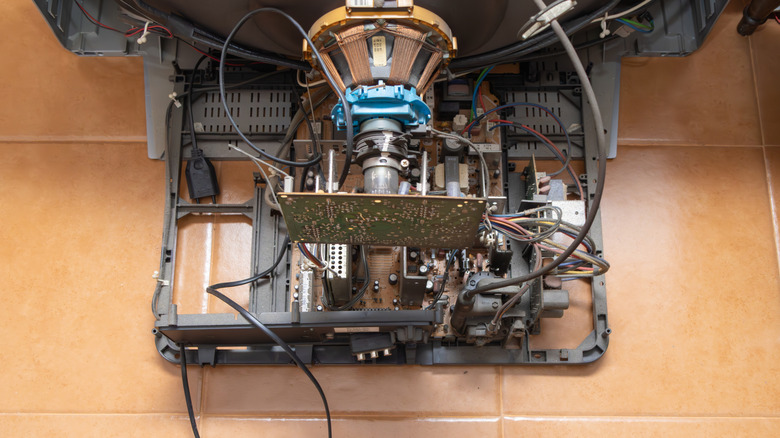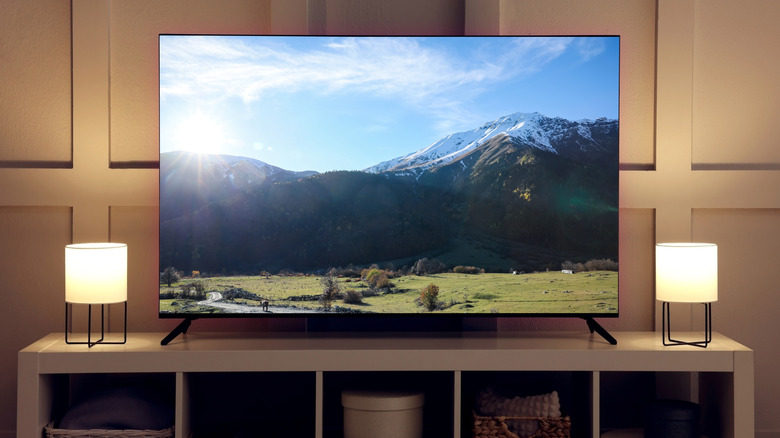Why TV Screens Don't Feel As Staticky As They Used To
If you were born before the mid-2000s, you probably grew up watching a television that looked nothing like the one you watch today. The TV sets of old were big, bulky boxes, sometimes deeper than the widths of their convex screens. They also behaved in a weird way that modern flat-screen televisions don't when you touch them.
Those old television sets generated a lot of static, and that's not referring to the white noise that would show up on screen when the signal went out. If you put your hand on that convex screen, you'd feel your fingers tingle with a discharge of static electricity, sometimes strong enough to make your hair stand on end. Modern flat-screen televisions still generate some static (all electronic devices do when they are turned on), but it's barely noticeable to the touch, if at all.
The reduction in TV screen static was brought about by the rise of flat-screen televisions, which were introduced in the late-1990s and came to dominate the market by the end of the 2000s. By then, TV had been the primary form of home entertainment for half a century, but in all those decades, television sets had been built almost exclusively with the same basic technology. Those big, bulky TVs of old used a technology called the cathode ray tube, or CRT, and it's the reason that older television sets could be seriously shocking to the touch.
Why CRT television sets were so staticky
A cathode ray tube is a vacuum chamber shaped like a funnel. The wide end of the funnel is the television screen, the inner side of which is coated in a layer of phosphor. At the narrow end of the funnel, you will find an electron gun, composed of the namesake cathode, as well as an anode. You've probably heard the terms cathode and anode used to refer to parts of a battery, the cathode being the positively charged end of the battery and the anode being the negatively charged end.
In a CRT TV, the cathode is a heated filament, like the kind used in a lightbulb, which emits a steady stream of electrons when it is powered on. The anode then collects those electrons and focuses them into a beam, which is projected onto the phosphor-coated back of the screen. The electrons make the phosphor glow, creating the visible images that entertain us.
CRT television sets required a very high-voltage electrical current to power the electron gun. These currents could reach 27,000 volts, ten times the lethal dose for humans (that's why opening up an old TV set was considered so dangerous). The powerful blast of electrons piling up would create a positive charge on the screen. If an object with a negative charge touches the screen, electrons will jump over and zap it. Human skin happens to be negatively charged, which is why you could get shocked by touching a CRT screen.
How modern TV sets have changed the game
Today, CRT televisions have been almost entirely phased out in favor of flat-screens. These TVs don't generate nearly as much static because they operate on more energy-efficient technology. Instead of using an electron gun that takes tens of thousands of volts to power, flat screens work by illuminating a grid of pixels. There are multiple kinds of flat screen technologies, but the two that you've most likely heard about are plasma screens and LCD TVs.
Plasma screen televisions have a display made up of hundreds of thousands of tiny cells filled with a plasma composed of xenon and neon atoms. When an electrical current is run through one of these cells, it causes the plasma to release ultraviolet energy. Each cell is coated in phosphor, just like old CRT screens, which converts the ultraviolet energy into visible light photons.
LCD stands for liquid crystal display. These TVs operate on the same basis as plasma screens, except that they use a display of liquid crystals instead of plasma-filled cells. The liquid crystals can be arranged in different orientations when an electrical charge is passed through them.
There's another perk to the flat-screen switch that can save you a little time on housecleaning. If you can recall living with a CRT television, you may remember how dusty the things always got. That's because the staticky screens of cathode ray tubes attracted dust particles. The advent of flat screen TVs has saved us all more dusting than we know.


